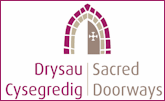Church of St Sulien and St Mael, Corwen
Corwen churchyard may have been in religious use since before Christianity came to Wales. A prehistoric standing stone is incorporated into the porch. A circular stone which probably once rested on a burial chamber lies in the churchyard, providing the base for the shaft of a cross which may have been carved in the 10th or 11th century.
Early Christian missionaries, in the 6th or 7th century, may have been attracted to the site by its established religious use and by the spring, just above the churchyard, which would have provided water for baptising converts.
 By 1222 there were 16 clerics at Corvaen, reflecting its regional importance. The church building in the 13th century was unusually large, as was the parish – covering 13 townships. The church tower was probably added in Tudor times. The church windows were described in 1730 as “lamentable” for admitting too little light, and by 1777 money had been raised to provide more and bigger apertures.
By 1222 there were 16 clerics at Corvaen, reflecting its regional importance. The church building in the 13th century was unusually large, as was the parish – covering 13 townships. The church tower was probably added in Tudor times. The church windows were described in 1730 as “lamentable” for admitting too little light, and by 1777 money had been raised to provide more and bigger apertures.
The lintel over the priest’s doorway is marked with a cross, reputedly carved by Owain Glyndŵr’s dagger. Inside the church is the effigy of Iorwerth Sulien, once vicar of Corwen. It’s thought to date from the 14th or 15th century. Unusually the upper part is in relief, but from the waist down the detail is level with the surface.
The font dates from the 11th century and features Norman “cable pattern” around the base. A window in the south wall commemorates Robert Dylan Vaughan Jones, a local soldier who was killed in Northern Ireland in 1979 and is named on Corwen war memorial.
Beside some of the graves (on the left as you approach the porch) are kneeling stones, where people prayed for the departed. Such stones are found only in a few churchyards, all in this area of Wales.
Under the yew tree west of the church is the grave of a GWR locomotive driver called Owen Owen, who died on 5 April 1872 aged 29 (a newspaper family notice at the time recorded him as Owen Owens, and his date of death as 4 April). His epitaph includes shunting, whistling, signals and other railway terms.
The old photo of the church, courtesy of the National Library of Wales, was taken by John Thomas c.1875.



